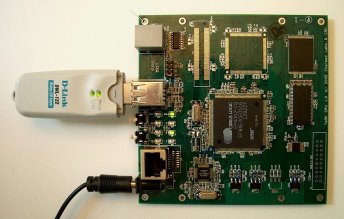Research Direction
TeRK is comprised of the following six major research and development thrusts:

Robot Reference Design Library
Our research has shown that educational engagement is maximized when students are exposed fully to all of the mechanical, electronic and computational challenges of robot systems science. Led by H. Benjamin Brown, we are designing a set of robot building recipes for diverse robot structures using exclusively COTS parts and hand tools. Each recipe, which will be fully sourced on-line, provides both a pathway for robot creation by the end-user and a pathway for production and sales by any Robotics store, as happened with our Palm Pilot Robot Kit several years ago. Robot reference designs in year 1 include a high-DOF arm, a large telepresence robot for home and office, and a small quick-build desktop robot.


Robot Embedded Electronics Package
Recent technology advances enable an on-board robot electronics package that is essentially single-board while providing all the needed functionality for diverse robot platforms. In cooperation with Charmed Labs LLC, we are producing and releasing such a package with the following characteristics:
- Hybrid Cirrus ARM9 – Xilinx FPGA processor design
- Ethernet, Wireless 802.11, Serial, and USB connectivity
- Digital i/o and Analog inputs (12 bits each)
- 10 dedicated servo output lines
- 4 dedicated DC motor drivers, 4 amps each
- Back-EMF and quadrature encoder-based feedback on-board
- High efficiency power-switching regulation for all power needs, with variable 7.2V battery “bus”
- Out-the-box internet connectivity to our diagnostic applications, telepresence client, iconic programming client and programming languages client.
- BOM approaching $200
Robot Connectivity and Development Software
Out-the-box robot connectivity is designed for early and rich, rewarding interaction. When built, a robot can be immediately connected to the internet, enabling diagnostic control, telepresence control and programming of the robot from any internet-enabled PC. We are developing the 802.11 driver software as well as the server software on-line to provide this level of immediate connectivity. We believe this is a crucial step in catalyzing user creativity and enjoyment, leading to high rates of retention and exploratory use.
Community Curriculum Design Effort
We have engaged a number of partners in the high school, community college and college levels to co-write curriculum with us for iterative development and dissemination. This effort includes creation of curriculum dissemination structures as well as standards for solution set materials.
Pilot Education and Evaluation Rollout
In cooperation with our partners at the University of Pittsburgh UPCLOSE/LRDC, we are planning a formal rollout and educational evaluation process which we will use to measure the efficacy of the TeRK package in college and pre-college educational settings. Early pilot experiments, combined with in vivo evaluation as the community builds, will enable follow-on refinements of the TeRK package.
Web-based Community Dissemination
Broad dissemination demands particular attention to use cases for various stakeholders who will use TeRK for a variety of purposes. We are working with our colleagues in web design at LotterShelly Inc. to create a web community site that will be accessible and efficient for all primary use cases of TeRK. We implemented such a design approach with great success for the Personal Rover Project museum interface, now in use across the world.